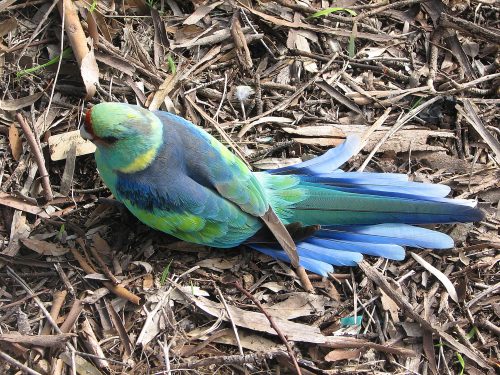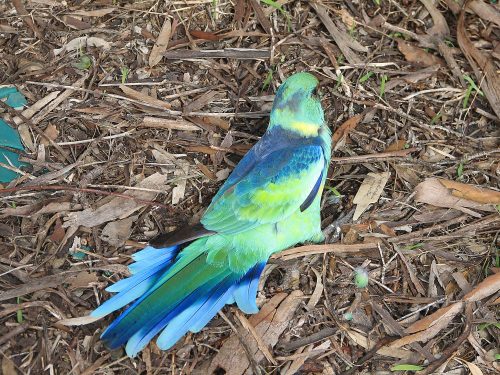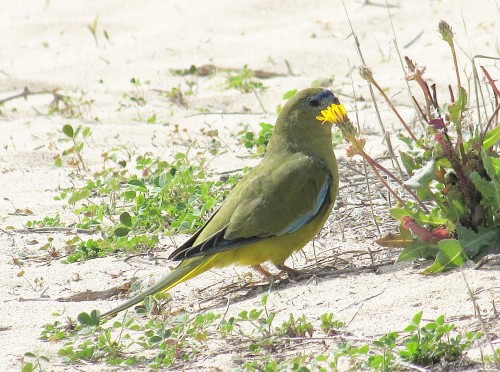Beautiful Mallee Ringneck Parrots
Over recent years we have had a family of Australian Ringneck parrots move into our garden. Before that, they were only occasional visitors, but now we see – or hear – them every day. They can be raucous at times. I now consider them to be a resident breeding species in our garden. In fact, only last week I witnessed two of them mating, so we could have even more around in the next few months. They have been constantly investigating a large hollow in one of our mallee trees. The birds we have here are the sub-species Mallee Ringnecks.
At first, we only had two birds, but after breeding, there were more, and now we often count up to about eight birds in our garden, or in the nearby mallee scrub. They chatter away noisily in the nearby trees, often disturbing the peacefulness of our edge of town block of land. We don’t really mind because we love having them around. That is – until they attack our ripening pears, chewing around the stems of each piece of fruit. Each summer I have to drape netting over the trees to minimise the damage.
Last week I was going out the sliding door on to our back veranda. I was heading out to sit in the weak winter sun to do some reading. One of the parrots flew from the nearby tree towards the house just as I came out of the door. It was flying directly towards me, wings and tail spread out fan-like as it came to a stop, landing on the edge of the roof guttering. As the feathers spread out, I glimpsed the beautiful colours of this lovely bird. Sadly, I didn’t have my camera – it happened far too quickly, anyway.
The photo at the top of this post shows the colourful feathers of one of our birds which accidentally flew into my office window last year. It sat on the ground quite stunned for a few minutes before flying off again. The photo below shows another shot of the same bird.
Further reading:
Sewage plants and parrots
What does a highway, a sewage plant and an endangered parrot have in common?
Not much if you think about it – except if the bird in question is an Orange-bellied parrot.
Although I have been birding in the places where this very rare and beautiful bird spends its winters, I have yet to observe one in its natural environment. They spend their winters along the southern coast of Victoria and the south eastern coast of South Australia, including the Coorong which is just over an hour’s drive from my home. In the summer months the little population flies over the wild and stormy Bass Strait to Tasmania where they breed.
When I say “little population”, latest counts suggest that as few as 75 individual birds exist in the wild. That is is getting perilously close to extinct.
So what about that question I posed at the beginning? To answer that question you need to read an interesting article called “A highway, a sewage plant and an endangered parrot.” One very interesting fact I learned from the article is that the Orange-bellied parrot is one of only two parrots world wide which migrate.
I don’t have a photo of an Orange-bellied Parrot – not even of one in a zoo – but below I have included a photo of a very similar species, the Rock Parrot. You will just have to imagine an orange patch on the belly!
Mallee Ringneck parrots feeding young
We have a family of 6 to 8 Mallee Ringneck parrots resident in our garden. We see them every day and they love feeding on the flowers of plants like the Eremophila shown in the photo above. They are also partial to our pears – before they are fully ripe. (Last summer we managed to foil them by draping bird netting over the trees. Yes!)
Quite often we have seen several of the parrots sitting at the entrance of a large hollow in one of our trees. We also see them entering and leaving this hollow. We’ve suspected that they have been nesting in this hollow, but we lacked definite proof until earlier this week.
My wife, who runs a small nursery growing Australian native plants (click to visit), was working in the nursery when she noticed a ringneck feeding a young one in the tree near her. So we can only assume that they have recently used the hollow (or another one nearby) to raise a family.
The Mallee Ringneck is a race of the Australian Ringneck.
King Parrots in Artarmon, Sydney
When we go to Sydney to visit family, we stay with our son and his family in Artarmon, several train station stops north of the Harbour Bridge. This area has many trees lining the streets, many more in gardens and there are several parks in the vicinity. While the birding is not great in terms of numbers of species, the bird life is still quite interesting.
The common species include: Noisy Miners, Australian Magpies, Australian Ravens, Common Mynas, Rainbow Lorikeets, Rock Doves, Laughing Kookaburras, Grey Butcherbirds and Pied Currawongs. From time to time I see Welcome Swallows, Galahs and Sulphur-crested Cockatoos. On one visit we even had a Boobook Owl in a tree in the garden.
More recently, my son – who has just a little more than a passing interest in birds – reported seeing a small group of 4 or 5 King Parrots frequenting his garden, or the street trees nearby. He hasn’t had a chance to get a photo yet, and I didn’t either on our recent visit last month. I did get several good views of them flying around nearby, but no clear views within camera range. Instead, I’ve included today a few photos of this species seen elsewhere.
A flock of Red-rumped Parrots
Sydney Trip June 2011
After lunch on the last day of our trip home from Sydney we drove around the Nature Drive in Hattah-Kulkyne National Park. This drive follows the shore of Lake Hattah and several other lakes. Part way along I spotted a flock of about 20 Red-rumped Parrots. They flew from the grass where they had been feeding and perched in one of the trees near the road.
While it is not a brilliant photo it does illustrate the beautiful green and yellow colours of the male birds.






